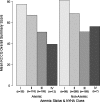Validity, reliability, and responsiveness of the Kansas City Cardiomyopathy Questionnaire in anemic heart failure patients
- PMID: 18165909
- PMCID: PMC2238779
- DOI: 10.1007/s11136-007-9302-5
Validity, reliability, and responsiveness of the Kansas City Cardiomyopathy Questionnaire in anemic heart failure patients
Abstract
Background: While generic health status measures quantify the impact of all patients' diseases on their health-related quality of life, disease specific measures focus on only one of the many conditions that a patient may have. If a patient has two diseases with similar clinical manifestations, they may respond differently to a disease-specific instrument if one of their conditions improves while the other worsens or remains stable, thus undermining the instruments in that patient population. We sought empirical evidence of the reliability and validity (including responsiveness) of the Kansas City Cardiomyopathy Questionnaire (KCCQ), a disease-specific measure for heart failure (HF), among HF patients with and without anemia, a condition that has similar symptoms to HF.
Methods: This work used a prospective cohort study of 811 HF outpatients from 58 U.S. centers with a baseline assessment of anemia of whom 698 were followed for 3 months with serial health status measures.
Results: Among participants, 268 (33%) were anemic. The construct validity of the KCCQ was supported by showing similar correlations with the New York Heart Association (NYHA) classification in patients with and without anemia (P value for interaction = 0.38). The internal consistency (Cronbach's alpha = 0.92 and 0.93 for anemic and non-anemic patients, respectively) and test-retest reliability (mean 3-month change scores in stable patients = -2.8 [SD = 1.4] and -0.5 [SD = 0.8], P = 0.14) were similar. Estimates of responsiveness were also similar.
Conclusion: This study provides empirical evidence that the psychometric properties of the KCCQ are similar in patients with or without anemia, a potentially confounding clinical condition in patients with heart failure.
Figures
References
-
- {'text': '', 'ref_index': 1, 'ids': [{'type': 'DOI', 'value': '10.1016/j.cardfail.2005.04.002', 'is_inner': False, 'url': 'https://doi.org/10.1016/j.cardfail.2005.04.002'}, {'type': 'PubMed', 'value': '15948091', 'is_inner': True, 'url': 'https://pubmed.ncbi.nlm.nih.gov/15948091/'}]}
- Normand, S. L., Rector, T. S., Neaton, J. D., Pina, I. L., Lazar, R. M., Proestel, S. E., Fleischer, D. J., Cohn, J. N. & Spertus, J. A. (2005). Clinical and analytical considerations in the study of health status in device trials for heart failure. Journal of Cardiac Failure, 11, 396–403. - PubMed
-
- {'text': '', 'ref_index': 1, 'ids': [{'type': 'DOI', 'value': '10.1067/mhj.2001.119135', 'is_inner': False, 'url': 'https://doi.org/10.1067/mhj.2001.119135'}, {'type': 'PubMed', 'value': '11685157', 'is_inner': True, 'url': 'https://pubmed.ncbi.nlm.nih.gov/11685157/'}]}
- Spertus, J. (2001). Selecting end points in clinical trials: What evidence do we really need to evaluate a new treatment? American Heart Journal, 142, 745–747. - PubMed
-
- {'text': '', 'ref_index': 1, 'ids': [{'type': 'DOI', 'value': '10.1016/j.jacc.2005.08.022', 'is_inner': False, 'url': 'https://doi.org/10.1016/j.jacc.2005.08.022'}, {'type': 'PubMed', 'value': '16168273', 'is_inner': True, 'url': 'https://pubmed.ncbi.nlm.nih.gov/16168273/'}]}
- Hunt, S. A. (2005). ACC/AHA 2005 guideline update for the diagnosis and management of chronic heart failure in the adult: A report of the American College of Cardiology/American Heart Association Task Force on practice guidelines (writing committee to update the 2001 guidelines for the evaluation and management of heart failure). Journal of the American College of Cardiology, 46, e1–e82. - PubMed
-
- {'text': '', 'ref_index': 1, 'ids': [{'type': 'PubMed', 'value': '10736296', 'is_inner': True, 'url': 'https://pubmed.ncbi.nlm.nih.gov/10736296/'}]}
- Quality of Care, Outcomes Research in CVD and Stroke Working Group (2000). Measuring and improving quality of care: A report from the American Heart Association/American College of Cardiology first scientific forum on assessment of healthcare quality in cardiovascular disease and stroke. Circulation, 101, 1483–1493. - PubMed
-
- {'text': '', 'ref_index': 1, 'ids': [{'type': 'PubMed', 'value': '10736303', 'is_inner': True, 'url': 'https://pubmed.ncbi.nlm.nih.gov/10736303/'}]}
- Krumholz, H. M., Baker, D. W., Ashton, C. M., Dunbar, S. B., Friesinger, G. C., Havranek, E. P., Hlatky, M. A., Konstam, M., Ordin, D. L., Pina, I. L., Pitt, B. & Spertus, J. A. (2000). Evaluating quality of care for patients with heart failure. Circulation, 101, E122–E140. - PubMed
Publication types
MeSH terms
LinkOut - more resources
Full Text Sources
Medical
Research Materials
Miscellaneous



